An easy and simple, creamy chicken congee recipe that is comforting any time of the year as an everyday meal or when you're feeling under the weather.
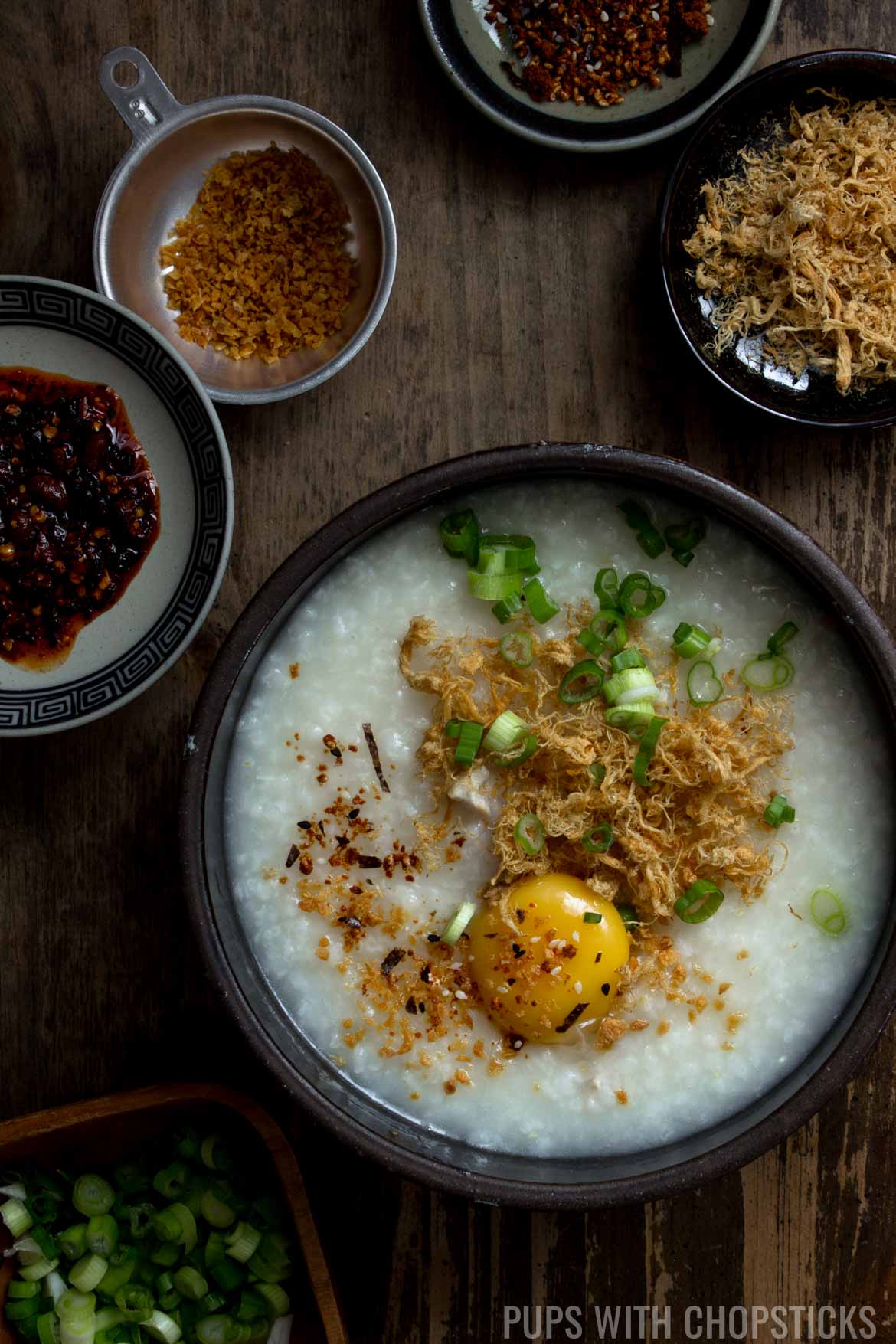
Table of Contents
What is Congee? (aka Jook)
Congee is essentially an Asian porridge made with rice, I like to think of it as a thick rice soup. It's comforting, easy to make, warm, and it is the ultimate Asian comfort food, which is why many of us turn to this wonderful dish whenever we're not feeling well. At its core, congee is just rice and water boiled down to a thick and creamy consistency and served with many different types of proteins and toppings.
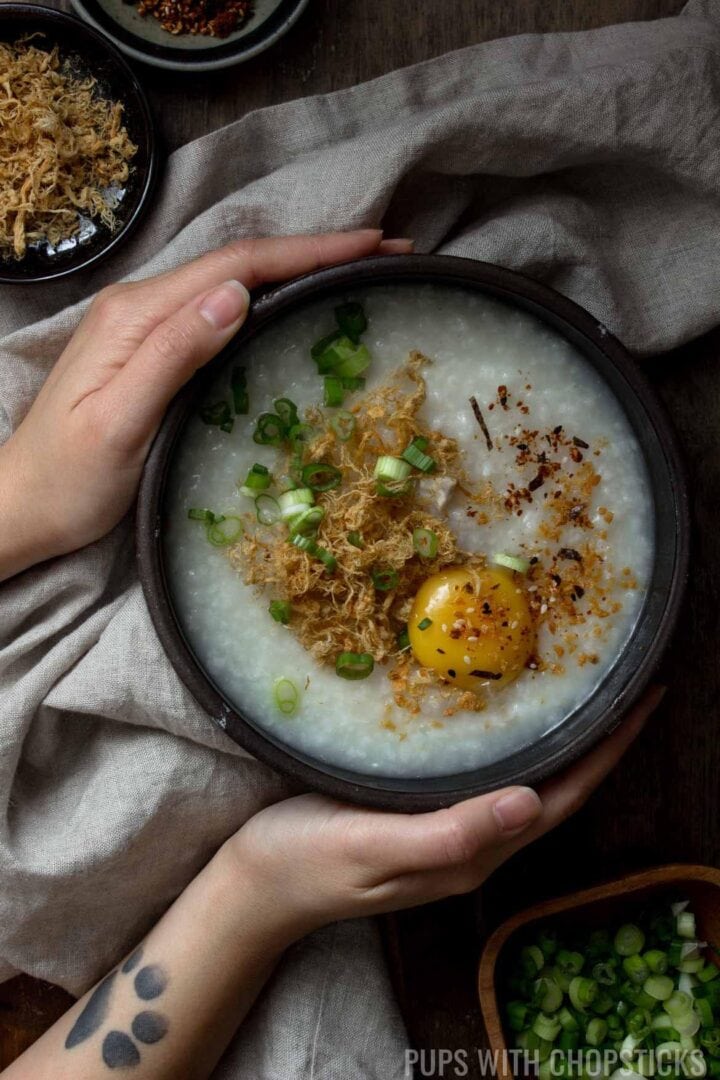
One of the many reasons why Asians usually have congee when they are sick is because it's a simple dish. It doesn't have a lot of ingredients in it, is easy to digest, has a lot of water in it to hydrate the body, and has a bit of protein in it as well if it is being made with a bit of meat. It is especially good when you don't have the appetite or energy to eat a full meal or when you can't hold your food down.
Although congee is something that is commonly eaten when people are sick, it is also eaten as a meal for breakfast or lunch as well which makes this a highly versatile dish! As a meal, it can be commonly cooked with any type of meat and seafood and it can be loaded with different kinds of flavorful congee toppings and condiments like chili oil!
Ingredients and Substitutions
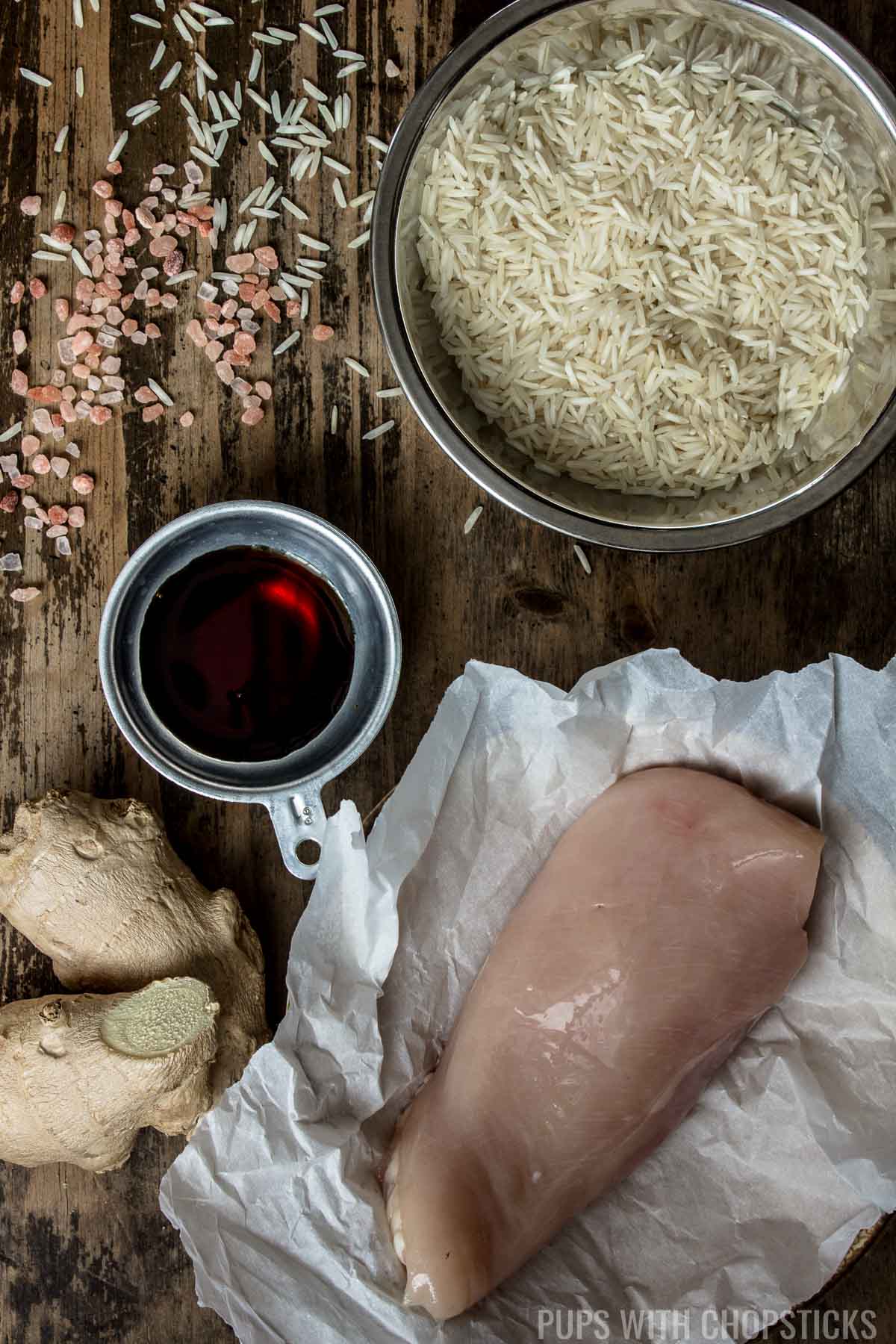
- Rice - I like to use Japanese medium grain rice (Calrose) to make my rice porridge because I find it comes out the creamiest. I go into more detail in the section below about other types of rice you can use as well.
- Water - You can use either water or chicken broth to make congee.
- Meat - When it comes to congee, you can use any kind of meat or seafood as your protein. For this recipe, we use chicken. The easiest and most convenient type of meat to use is ground meat (ground chicken, beef, or pork). Ground meat also tends to cook faster as well.
Different Types of Rice and Cooking Time
- Japanese medium grain rice (calrose) - Congee can be cooked with many different kinds of rice but my favorite way to make it is by using Japanese medium grain (Calrose) rice. I prefer this type of rice because I find it gives me a good balance of creamy mixed with a bit of heartiness - I also find it makes the thickest type of congee as well. Everyone will have a different preference, so experiment until you find your perfect blend. When you are using this type of rice to make congee, it will take less time to thicken and you will need to stir it constantly because of how thick it will be, so it doesn't stick to the bottom of the pan and burn.
- Jasmine Rice - Alternatively, you can use jasmine rice to make congee as well. Jasmine rice will produce a lighter and silkier congee.
- Basmati Rice - Although not a traditional rice used in congee, I will still occasionally use this type of rice mixed in with my congee to give it a bit more substance. I find using basmati rice gives a heartier texture to congee.
How to Make Chicken Congee
Marinade the Chicken
- Thinly slice the chicken so it cooks quickly (¼ inch or less) and place it in a bowl. If you are using ground chicken or pork then place that in a bowl.
- Add in the soy sauce, water and oil, and corn starch to the chicken and mix well. Set it aside for later.
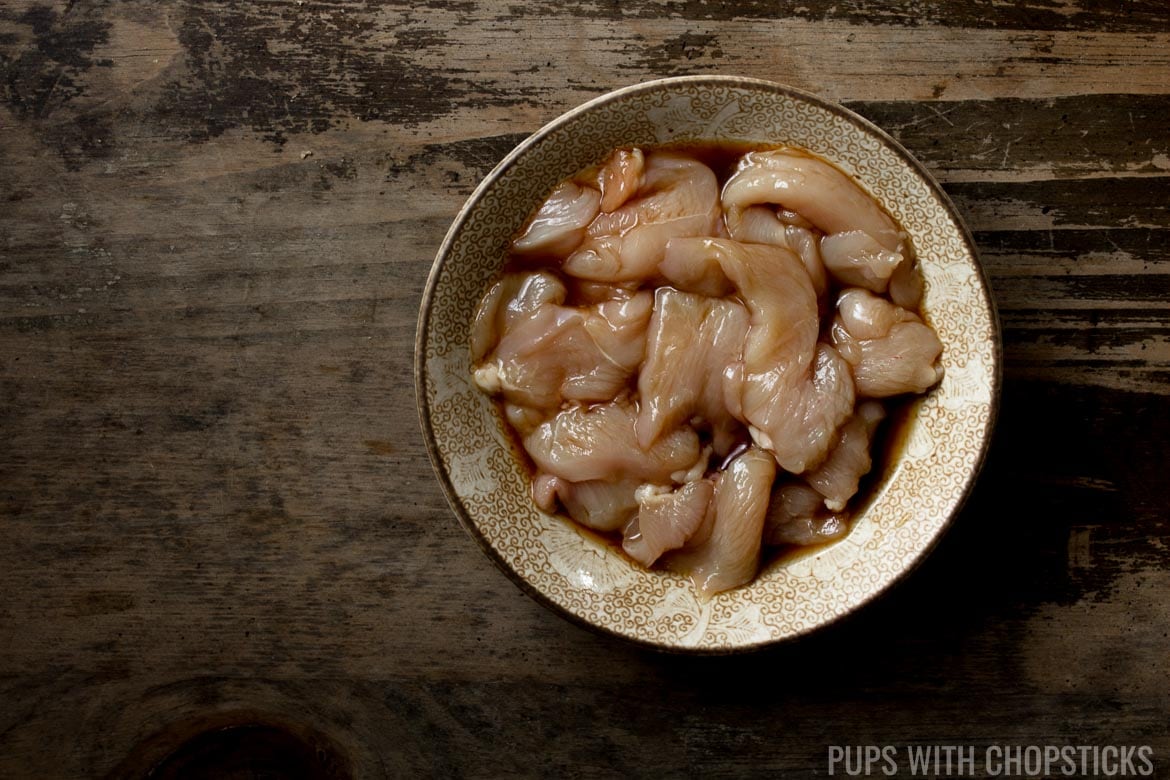
Cooking the Congee
- Rinse the rice in cold water a few times over the sink and drain it.
- Set the stove to high heat and add water and ginger slices to the pot and wait for it to boil.
- Once the water has started to boil, add in the rice. It's important the water is boiling before you add in the rice so that it doesn't settle on the bottom and stick.
- Once the congee has boiled for about 5 minutes, turn down the heat to medium low heat and let it simmer with no lid on. Please do not use a lid while it is simmering. It will cause the starchy congee to overflow out of the pot.
- It will take about 30 minutes to cook. Stir it every 10-15 minutes so it doesn't stick to the bottom of the pan and burn. (If you used basmati rice, you will need to add 15-20 minutes to the cooking time)
- Once the congee is done, turn off the heat and put a lid on it and let it 'steam' for 20 minutes. This will thicken the congee a bit more.
After 20 minutes, whisk the congee with a whisk or chopsticks quickly for 3-4 minutes to break up the rice grains so that the congee will be more creamy, and silky. At this point, adjust the congee to the texture you like. If you like it thinner, add more water/chicken stock to it, 2 tablespoons at a time until you get the right consistency. If you like it thick and creamy, leave it as is.
Cooking the Chicken
- Turn the heat back to medium heat and keep stirring until the congee is hot and starts to bubble.
- Once the congee starts to bubble, add in the chicken slices or ground meat and stir well so that the hot congee fully covers the meat.
- Cook the meat for about 2-3 minutes or until it is cooked.
- Salt is very important for congee to taste good. Don't be shy with it. Add salt to taste.
- Garnish with finely chopped green onions or additional toppings and enjoy!
Tips
- Make sure you cut or slice your chicken as thin as you can so that it can cook quicker in the congee. I like to make sure no pieces are thicker than ¼ inch.
- It is important to marinate the chicken before we cook it. It keeps the meat tender, silky and moist even if you overcook it.
- Do not use a lid when the congee is slowly simmering in the pot. The starchiness of the congee with cause it to overflow over the pot if you cover it.
- If you're pressed for time and you want to make congee faster, rinse a big batch of rice and keep a stash in the freezer. When the rice freezes, the ice breaks down the molecules of the rice which helps reduce the cooking time.
- You can add salted duck egg in the congee while it's cooking, to give it extra saltiness and flavor!
Congee Toppings
If you are having jook because you are sick, keep the toppings simple and not add too many toppings that may irritate your throat.
If you are having jook as a meal or you're looking for what to put in congee, then I highly suggest you go crazy on the toppings and experiment with it until you find a combination you like! It's fun, and tasty and it can give chicken congee a bit more variety!
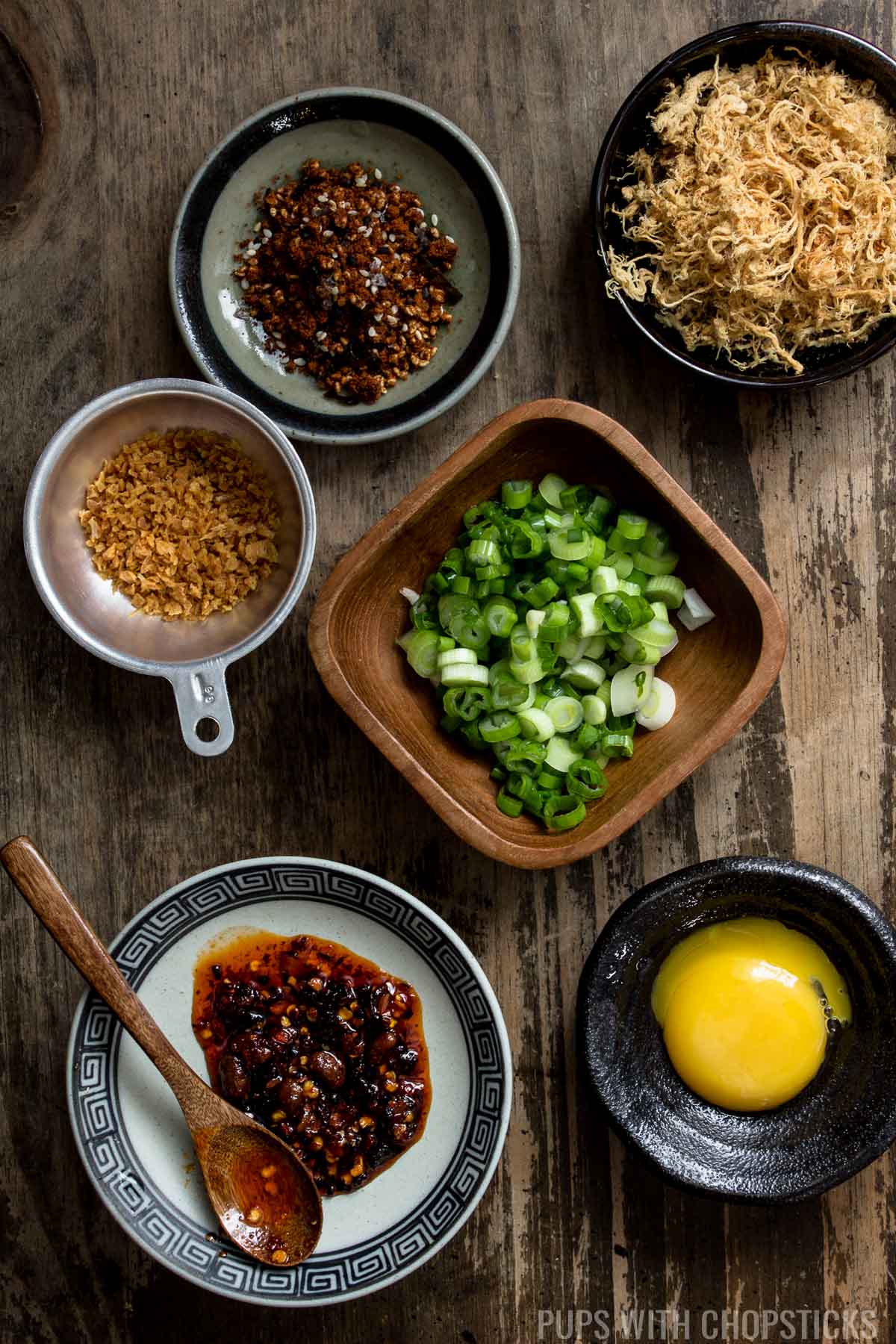
Here are a few ideas that I like to use to jazz up my chicken congee!
If you're looking for ideas and ways to top your congee, I also have a more extensive congee topping ideas post here as well.
- Raw egg or fried egg
- Green Onions
- Pork Floss
- Chinese Chili Oil
- Crispy Fried Garlic
- Store-bought furikake (or Homemade furikake)
- Crispy fried onions/shallots
- Cooked salted duck egg
- Cilantro
- Crushed roasted peanuts
- Fermented bean curd
- Preserved sweet radish (the sweet kind)
- Pickled mustard greens
- Shiitake mushrooms braised in sweet soy sauce
- Sesame oil
- Fish sauce or soy sauce
- Crispy pan-fried spam or Chinese sausage (lap cheong)
- Toasted sesame seeds
- Chinese Donuts (You Tiao)
- Roasted Seaweed Snacks
The choices are endless! 🙂
Frequently Asked Questions
Yup! If you are sick or you need to make a big batch so you don't need to keep cooking it, then you definitely can store this in the fridge but I find that once you reheat it the next day, the congee will not be as thick and creamy like it was when it was fresh. You may need to use a potato starch slurry (1 tablespoon of potato starch mixed with 1 tablespoon of cold water) while it is boiling to re-thicken it again.
Once your congee is cooked and the rice is soft, I like to move the pot off the heat and put a lid on it for 20 minutes. The 20 minutes lets the rice steam in the residual heat so that it can soften further so that the rice can break apart more easily. After that 20 minute waiting period, I like to whisk or vigorously mix the congee for about 3-4 minutes - this helps break down the rice further into smaller pieces to make it even creamier and softer.
Yes, you definitely can. Using broth can give congee more flavor as well. I use water in this recipe to keep it simple, in case anyone is making this congee because they are not feeling well.
You can mix a bit of salt and oil onto the rice after you have washed it and let it sit for 30 minutes before using it.
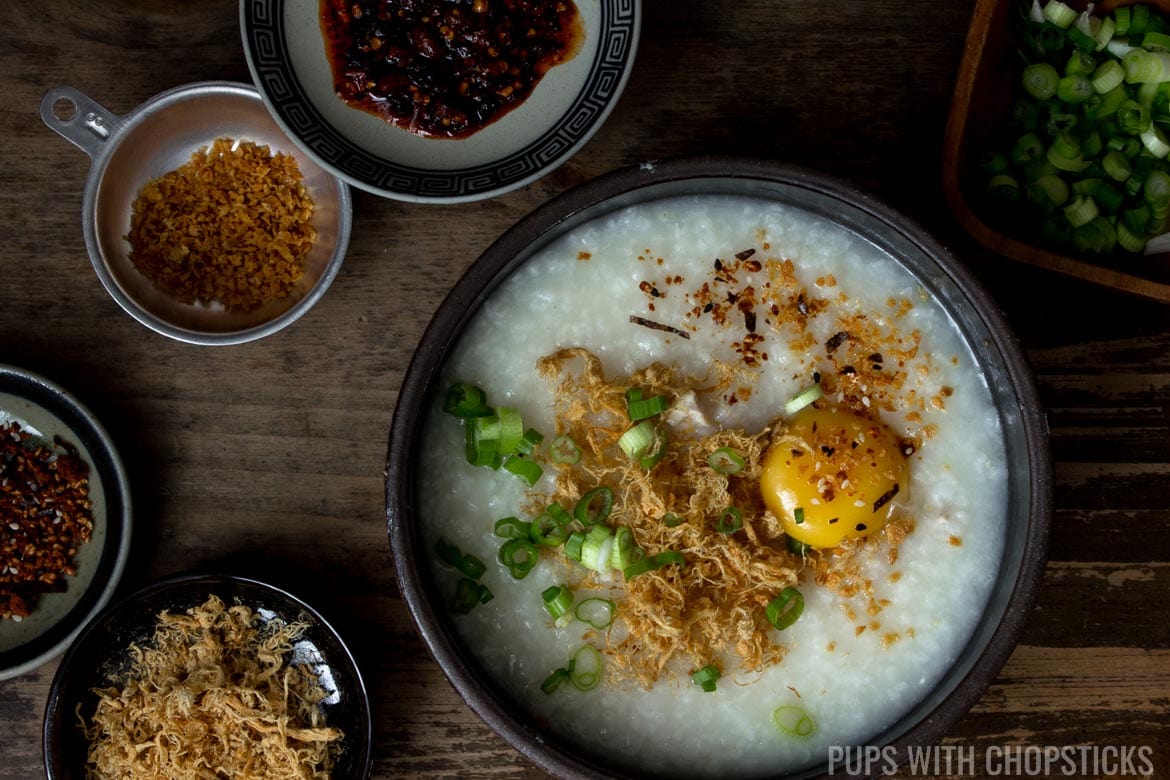
More Asian Comfort Foods You May Like
- Tomato and Egg Stir Fry (Chinese Style)
- Miso Corn Egg Drop Soup Recipe
- Three Cup Chicken (San Bei Ji)
- Chinese Hot Pot Recipe Guide
- Khao Soi (Thai Coconut Curry Noodle Soup)
- Spicy Soondubu Tofu Stew (Soondubu Jjigae)
- Longevity Noodles (Yi Mein)
- Chinese Braised Beef Stew
- Steamed Chicken with Shiitake Mushrooms and Chinese Sausage
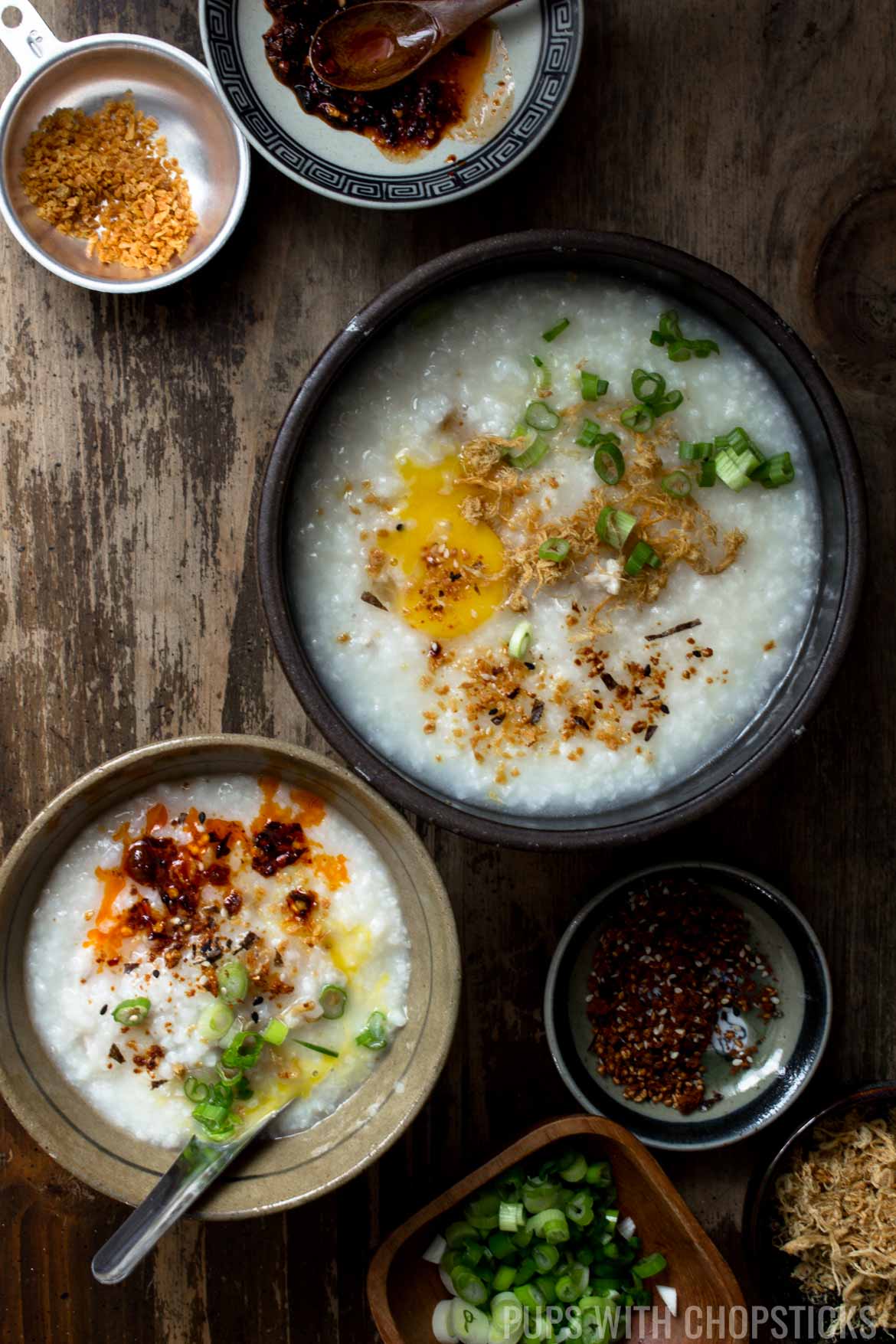
If you like my recipes and want to be updated on when new ones come out, please consider subscribing to my newsletter (we don't spam) and follow along on Instagram, Facebook, and Pinterest for all of my latest recipes!
Recipe Card
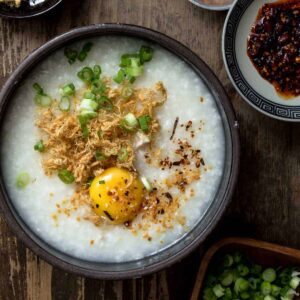
How to Make Chicken Congee (鸡粥)
Joyce's Recipe Notes
- If you are using Japanese Calrose Rice for this recipe, the congee will turn out very creamy and thick. If you like your congee soupier, add more water or chicken stock, 2 tablespoons at a time until it is the right consistency for you at the end before you cook the chicken.
- If you are making a big batch of congee, it may not be as thick and creamy the next day. If you'd like to thicken it, you can mix in a potato starch slurry (1 tablespoon of potato starch mixed with 1 tablespoon of cold water) while it is boiling to re-thicken it again.
- If you are making a larger batch of this recipe (like making a double batch by doubling the ingredients), you may need to increase both the 'cooking time' and 'steaming time' by 15 minutes, for a total of an extra 30 minutes.
Ingredients
- ½ cup Japanese medium grain rice (calrose)
- 7 cups water (or chicken stock)
- 2 slices ginger (optional, but highly recommended)
- salt (to taste)
Chicken Marinade
- 1 chicken breast or ¼ lb of ground chicken
- 1 tablespoon soy sauce
- 1 tablespoon water
- 2 teaspoons oil
- ½ teaspoon corn starch
Toppings (Optional)
- Green Onions (Thinly sliced. Highly Recommended)
- Pork Floss (Highly recommended)
- Crispy Deep Fried Garlic or Fried Onions (Highly Recommended, You can make this at home as well.)
- Furikake ( or make a batch, Homemade Furikake)
- raw egg yolk
- Salted Duck Egg (Cooked)
- Toasted Sesame Seeds
- chili oil
- Sesame Oil
Instructions
Marinade the Chicken
- Thinly slice the chicken so it cooks quickly (¼ inch or less) and place it in a bowl. If you are using ground chicken or pork then place that in a bowl.
- Add in the soy sauce, water and oil, and corn starch to the chicken and mix well. Set it aside for later.
Cooking the Congee
- Set the stove to high heat and add water and ginger slices to the pot and wait for it to boil.
- Once the water has started to boil, add in the rice and stir it for a few minutes. We don't want the rice to settle at the bottom and stick to the pot.
- Once the congee has boiled for about 5 minutes, turn down the heat to medium low heat and let it simmer with no lid on. Please do not use a lid while it is simmering. It will cause the starchy congee to overflow out of the pot.
- It will take about 30 minutes to cook. Stir it every 10-15 minutes so it doesn't stick to the bottom of the pan and burn. (If you used basmati rice, you will need to add 15-20 minutes to the cooking time)
- Once the congee is done, turn off the heat and put a lid on it and let it 'steam' for 20 minutes. This will thicken the congee a bit more.
- After 20 minutes, whisk the congee with a whisk or chopsticks quickly for 3-4 minutes to break up the rice grains so that the congee will be more creamy, and silky. At this point, adjust the congee to the texture you like. If you like it thinner, add more water/chicken stock to it, 2 tablespoons at a time until you get the right consistency. If you like it thick and creamy, leave it as is.
Cooking the Chicken
- Turn the heat back to medium heat and keep stirring until the congee is hot and starts to bubble.
- Once the congee starts to bubble, add in the chicken slices or ground meat and stir well so that the hot congee fully covers the meat.
- Cook the meat for about 2-3 minutes or until it is cooked.
- Salt is very important for congee to taste good. Don't be shy with it. Add salt to taste.
- Garnish with finely chopped green onions or additional toppings and enjoy!
Nutrition
*Nutritional information is calculated using online tools and is an estimate*
Disclaimer: We are a participant in the Amazon Services LLC Associates Program, an affiliate advertising program designed to provide a means for us to earn fees by linking to Amazon.com and affiliated sites. While I appreciate the support - please try to buy your items locally if possible to support your local shops (chances are they are cheaper locally as well!) 🙂

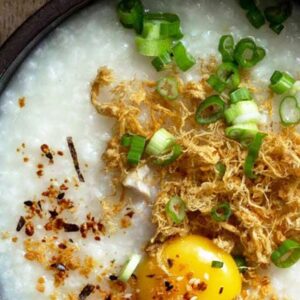
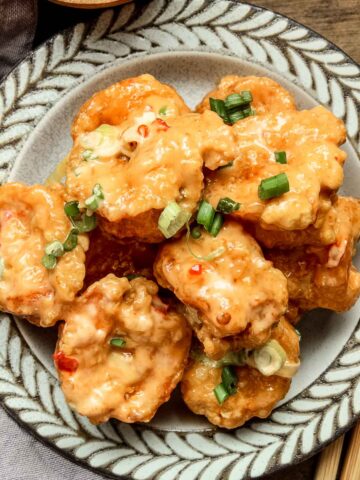
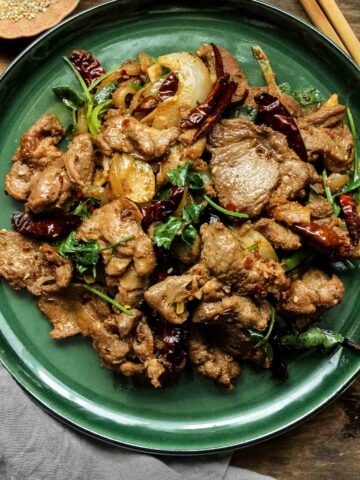
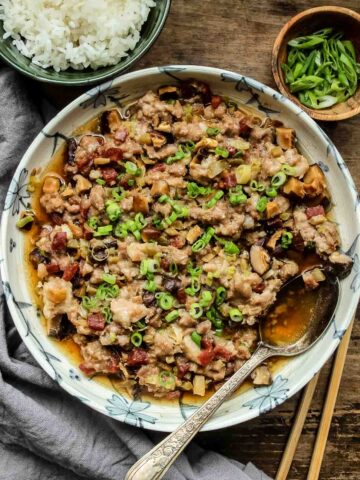
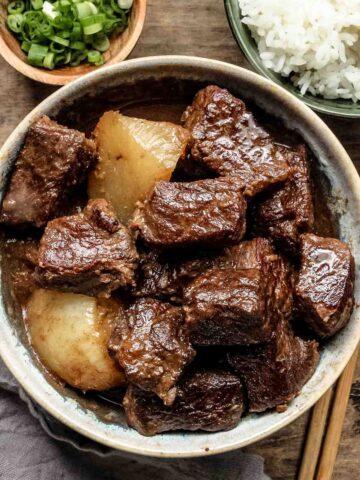
Kristen says
Made last night. It was easy and I only had long grain rice but it worked out. This was my first time making congee and this recipe made it easy and turned out so delicious and comforting. Making it again.
Joyce Lee says
Hi Kristen!
Yay! Thanks so much for letting me know! I am super happy this turned out for you! 😊
Aisha says
It's my first time making congee and it turns out SO GOOD! Plus I was sceptical if it'll work because I only have basmati rice but it did and it's very easy to make! It's just takes time and it's worth it 🥺❤
Joyce Lee says
Hi Aisha!
I'm so happy you liked it! It's always intimidating the first time the first time I make or try things too so I hear you. 🙂
I'm glad the basmati worked out for you as well, most people would freak out and say its not the traditional type of rice to use but I say, sometimes you just need to break the rules and experiment, and most of the time its fine. 🙂 I also find basmati doesn't break down as finely so it gives you a heartier congee which is equally as delicious depending on what you're going for 🙂
LaVonne Bunt says
Love your recipes and love your website --- delicious!
Joyce Lee says
Hi LaVonne!
Thank you so much for your kind words! It means a lot to me!
Casey says
I can't believe how easy and good this recipe is. I discovered it a few months ago and have made it several times since then, and I imagine I'll make it several more times now that the weather is getting colder. Thank you!!
Joyce Lee says
Hi Casey!
It's the perfect season for it right now too with the cold weather outside! I'm so happy you liked this recipe, I am super happy to be able to share this with you.
AJ says
Hi,
What if I am using rice cooker to cook the congee?
Joyce Lee says
Hi AJ,
I haven't tried using a rice cooker to cook congee, so I am not really sure what the timing of that would be for it. Sorry I couldn't be more help!
Ichwan says
Thanks very good recipe
Joyce Lee says
Hi Ichwan,
I'm happy you liked it, I'm happy to share!
jossie says
I love your EASY CREAMY CONGEE SOUP the ingredients you put into are so different from the normal recipe. You make you really easy, and simple and very tasty too. Thank you.